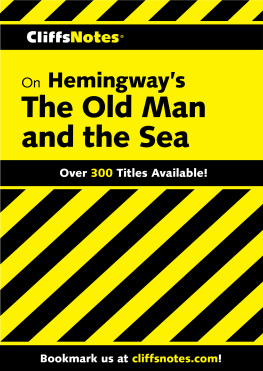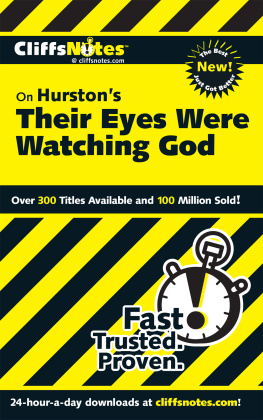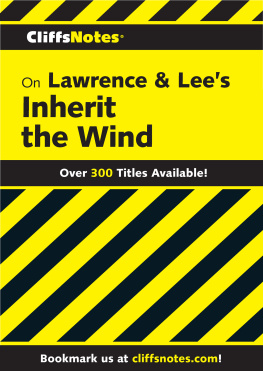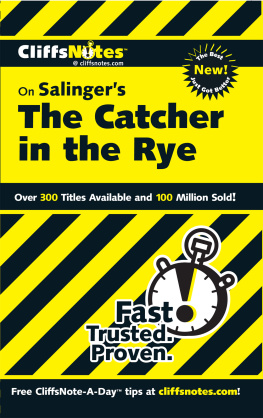Copyright 2001 Houghton Mifflin Harcourt Publishing Company
All rights reserved.
hmhco.com
cliffsnotes.com
For information about permission to reproduce selections from this book, write to or to Permissions, Houghton Mifflin Harcourt Publishing Company, 3 Park Avenue, 19th Floor, New York, New York 10016.
The publisher and the author make no representations or warranties with respect to the accuracy or completeness of the contents of this work and specifically disclaim all warranties, including without limitation warranties of fitness for a particular purpose. No warranty may be created or extended by sales or promotional materials. The advice and strategies contained herein may not be suitable for every situation. This work is sold with the understanding that the publisher is not engaged in rendering legal, accounting, or other professional services. If professional assistance is required, the services of a competent professional person should be sought. Neither the publisher nor the author shall be liable for damages arising herefrom. The fact that an organization or website is referred to in this work as a citation and/or a potential source of further information does not mean that the author or the publisher endorses the information the organization or website may provide or recommendations it may make. Further, readers should be aware that Internet websites listed in this work may have changed or disappeared between when this work was written and when it is read.
Trademarks: CliffsNotes, the CliffsNotes logo, Cliffs, cliffsnotes.com, and all related trademarks, logos, and trade dress are trademarks or registered trademarks of Houghton Mifflin Harcourt Publishing Company. All other trademarks are the property of their respective owners. Houghton Mifflin Harcourt is not associated with any product or vendor mentioned in this book.
eISBN 978-0-544-18306-3
v1.1117
Life and Background of the Author
The following abbreviated biography of Ernest Hemingway is provided so that you might become more familiar with his life and the historical times that possibly influenced his writing. Read this Life and Background of the Author section and recall it when reading Hemingways The Old Man and the Sea, thinking of any thematic relationship between Hemingways work and his life.
Early Years
Ernest Miller Hemingway was born the second of six children in Oak Park, Illinois, on July 21, 1899. His mother, Grace, was a religious woman with musical talent, while his father, Clarence Edmonds (Ed) Hemingway, was an outdoorsman who loved hunting and fishing in the northern Michigan woods. From an early age, Ernest shared his fathers interests. He also vacationed with his mother on Nantucket Island and heard tales of his seafaring great-grandfather, Alexander Hancock. Much of what Hemingway learned in the early years about the outdoors and natures lessons became the basis of many of his stories, such as some of the Nick Adams stories and The Old Man and the Sea.
Hemingway attended Oak Park and River Forest high schools, where he wrote for the newspaper and the literary magazine and participated in sports such as boxing, swimming, and football. He didnt attend college but instead began working as a reporter for the Kansas City Star. Later, he also wrote for the Toronto Star and Star Weekly. His early journalistic career profoundly impacted his literary writing style, which was always honed and spare.
Experiences and Literary Achievements
Hemingway was rejected for regular military service in World War I because of a weak left eye, so he drove a Red Cross ambulance in Italy, distributing chocolate to Italian troops. While recuperating from serious wounds in a Red Cross hospital in Milan, Hemingway fell in love with nurse Agnes von Kurowsky, who later rejected him as too young. These World War I experiences eventually became invaluable fodder for his most famous war novel, A Farewell to Arms. The experiences contributed to many of his war novels recurring themes: the cruelty and stupidity of war, the greedy materialism and quest for power that cause war, the platitudes and abstractions that glorify war, and the value of enduring whatever must be endured.
As a foreign correspondent for the Toronto Star Weekly, Hemingway moved to Paris. Armed with a letter of introduction from Sherwood Anderson to Gertrude Stein, Hemingway established friendships with a number of famous expatriate writers who helped him develop his craft. Hemingway published In Our Time, a collection of short stories, some of them the Nick Adams stories set in Michigan. In 1923, Hemingway made the first of five consecutive yearly trips to Pamplona, Spain, for the bullfightsan experience that eventually served as a basis for The Sun Also Rises, which is about the expatriate life in Paris and Pamplona. In the epigraph of that book, Hemingway quotes a line that Gertrude Stein previously recounted: You are all a lost generation. The phrase lost generation quickly became a mantra of the post World War I generations attitude about the wars effect on their lives and the futility and meaninglessness of life.
In 1928, Hemingway moved to Key West, Florida, and began deep-sea fishing. That same year, his father committed suicide. In 1932, Hemingway went on a two-month fishing expedition to Havana and began marlin fishing, which eventually provided material for The Old Man and the Sea. In 1933, he continued fishing off the coast of Cuba, sailed to Paris, and then went on to Africa for a safari in Kenya and Tanganyika. The safari provided a setting for Green Hills of Africa.
As a foreign correspondent in Paris, Hemingway began to raise funds for the Loyalist cause in Spain. In 1937, he went to Spain as a war correspondent covering the Spanish Civil War, which gave him material for For Whom The Bell Tolls, his best-selling novel about an American volunteer and a band of Spanish Loyalist guerillas. Hemingways goals in the book included a clear depiction of the indifference of the worlds democracies to encroaching fascism and the desperate need to fight against it.
In 1939, Hemingway moved to Finca Vigia (Lookout Farm), a house near Havana, Cuba. When World War II began, he volunteered to serve as a spotter for the U.S. Navy, outfitting his own fishing boat, the Pilar, to hunt for German submarines off the Cuban coast. In 1944, he became a war correspondent for Colliers and covered the war, including the liberation of Paris, with the U.S. Fourth Infantry Division. Papa Hemingway, as he was dubbed, purportedly liberated the Ritz hotel in Paris, particularly the bar, just prior to the arrival of Allied troops.
After the war, Hemingway married his fourth wife, Mary Welsh, a Time magazine correspondent. Drawing on his World War II experiences, he published Across the River and Into the Trees, about a May-December romance. A subtle consideration of war in modern times, this book was less realistic and more symbolic than his previous work and was roundly attacked by critics. However, his 1952 publication of The Old Man and the Sea restored his reputation and earned Hemingway the Pulitzer Prize in 1953. In 1954, Hemingway won the Nobel Prize for Literature. The prize committee cited the power of his style, his mastery of narration, and his admiration for the individual who fights the good fight in a world of reality overshadowed by violence and death.
In 1959, Hemingway bought a home in Ketchum, Idaho. In declining health from diabetes, high blood pressure, and mental depression (possibly caused by a genetic illness unrecognized at the time), he attended the Spanish bullfights in 1960 and later celebrated his 60th birthday. At the Mayo Clinic, he twice underwent electric shock treatments, which didnt help him. So great was Hemingways stature as both a writer and legendary figure, the world mourned after his suicide by shotgun at his home in Ketchum on July 2, 1961.
Next page












